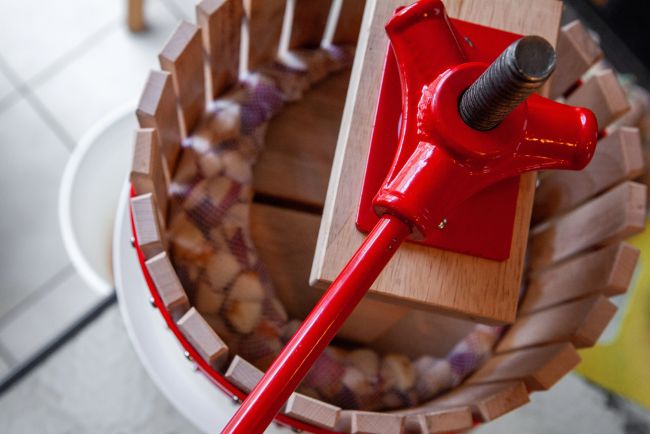Producing Your Own Cider and Apple Juice at Home

Using an Apple Crusher, Press, and Pasteuriser for Fresh Juice and Freezing
Making your own cider or apple juice at home is one of the most satisfying ways to use up an autumn glut of apples. With a few pieces of specialist equipment — an apple crusher (or mill), a press, and a pasteuriser — you can produce high-quality drinks for immediate consumption, freezing, or longer-term storage.
1. Choosing and Preparing Your Apples
- Apple varieties:
- For cider: use a mix of sharp (acidic), sweet, and bitter varieties for complexity.
- For juice: dessert apples give a sweeter drink, cooking apples add sharpness.
- For cider: use a mix of sharp (acidic), sweet, and bitter varieties for complexity.
- Ripeness: Fruit should be fully ripe but not overripe — avoid mouldy or heavily bruised apples.
- Cleaning: Wash apples in clean water to remove dirt and insects.
- Cutting: Remove any rotten parts, stalks, or large leaves.
2. Crushing or Milling
- Purpose: Crushing breaks down the fruit into a pulp, making it easier to press.
- Equipment: An apple crusher or scratter does the job quickly. If you don’t have one, a strong food processor or even a clean lump hammer and bucket will work for small batches.
- Tip: Aim for a coarse, moist pulp — too fine and the juice may be cloudy and harder to press.
3. Pressing
- Setting up: Place the apple pulp into a press lined with a mesh or muslin bag to catch solids.
- Press types:
- Traditional screw press – slower but easy for small quantities.
- Hydraulic press – faster, especially for larger batches.
- Traditional screw press – slower but easy for small quantities.
- Collecting the juice: Use clean, food-grade containers beneath the spout.
4. Pasteurising (for Juice)
- Why pasteurise? Kills bacteria and yeasts, allowing juice to be stored for months without fermenting.
- Method:
- Heat the juice in a pasteuriser to 75–80°C (167–176°F) for at least 20 seconds.
- Do not boil — this affects flavour.
- Immediately bottle in sterilised containers.
- Heat the juice in a pasteuriser to 75–80°C (167–176°F) for at least 20 seconds.
- Bottling tip: Use screw-top glass bottles or food-grade plastic containers, leaving a small gap at the top.
5. Freezing Apple Juice
- Best containers: Plastic bottles or cartons that allow for expansion (leave 2–3 cm headspace).
- Freezing: Fresh juice can be poured straight into containers without pasteurising before freezing.
- Storage life: Up to 12 months in a deep freezer. Defrost in the fridge and consume within 3–5 days.
6. Making Cider
- Fermentation basics:
- Use unpasteurised juice.
- Transfer to a clean fermenting vessel, fitting an airlock.
- Let wild or added yeast ferment for 3–6 weeks.
- Use unpasteurised juice.
- Secondary fermentation: Rack (siphon) into clean vessels to remove sediment and improve clarity.
- Maturation: Store in a cool place for at least 3 months before drinking; 6–12 months for best flavour.
7. Storage Advice
- Apple juice (pasteurised): Store sealed bottles in a cool, dark place for up to 12 months.
- Apple juice (unpasteurised, refrigerated): 3–5 days.
- Frozen juice: Up to 1 year.
- Cider (bottled): 12–18 months in a cool place.
- In old cider jugs (demijohns):
- Only store if the vessel is thoroughly cleaned and sterilised to avoid contamination.
- For cider: demijohns are ideal for bulk ageing, but once fermentation is complete, transfer to bottles to prevent oxygen spoilage.
- For juice: less suitable unless pasteurised and kept chilled — aim to consume within a few weeks.
- Only store if the vessel is thoroughly cleaned and sterilised to avoid contamination.
8. Hygiene and Safety Tips
- Always sterilise all equipment and containers before use.
- Avoid metal vessels (other than stainless steel) for juice storage, as acid in apples can react with some metals.
- Check for signs of spoilage — off smells, mould, or fizz in still juice mean it should be discarded.
Home-pressed apple juice and cider not only taste far fresher than shop-bought versions, they let you control sweetness, sharpness, and alcohol levels. With the right preparation, you can enjoy your apple harvest year-round — in a crisp glass of juice in February or a chilled cider in summer.